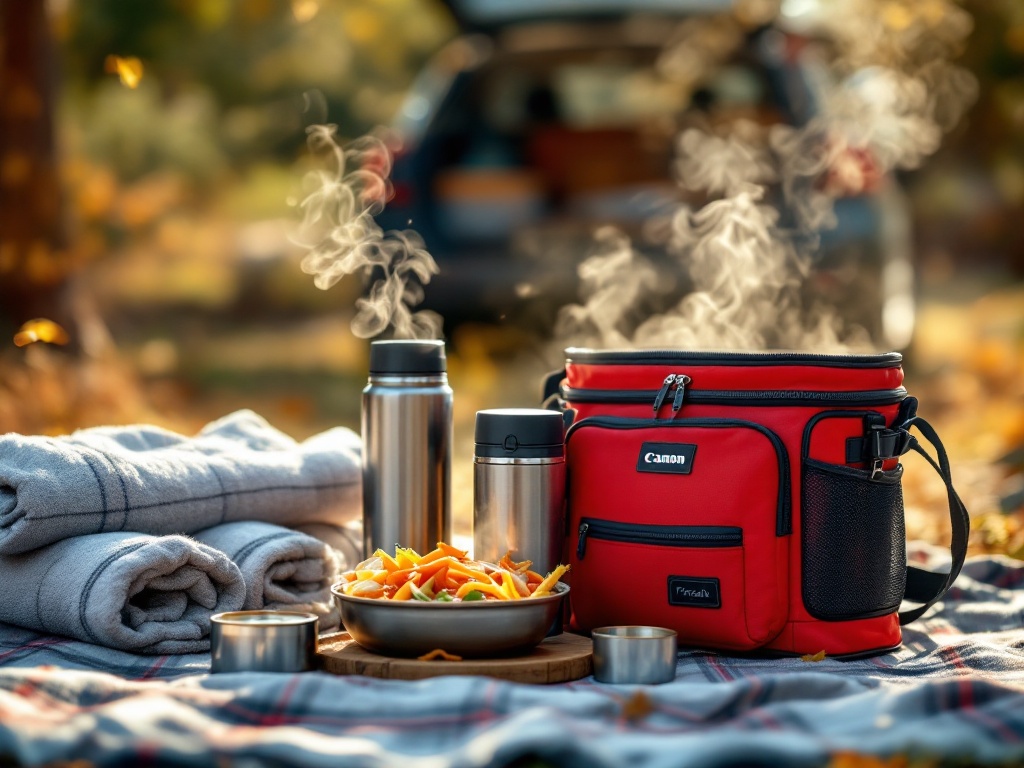How to Keep Food Hot while Traveling: Tips and Tricks
Enjoy hot, delicious, and safe meals on the go! Learn how to keep food above the crucial 140°F (60°C) safety zone, preventing bacterial growth like Salmonella and E. coli. Discover effective methods using thermoses, thermal bags, and even clever tricks with aluminum foil and towels. Explore 12V travel warmers and other vehicle-specific solutions for maintaining ideal food temperatures during any journey. Read on to elevate your travel dining experience.
Important information

- Maintain food at 140°F (60°C) or higher to prevent bacterial growth and ensure food safety.
- Use insulated containers like thermoses (for individual portions) and thermal bags (for larger quantities) to keep food hot.
- Boost insulation by wrapping food in foil, towels, or even newspaper.
- 12V travel food warmers are helpful for road trips; heat packs offer supplemental warmth.
- Separate hot and cold food items to maintain desired temperatures and prevent cross-contamination.
Understanding How to Keep Food Hot while Traveling
Maintaining your food’s temperature during travel is essential for taste and safety. Hot food is more enjoyable and easier to digest. Moreover, keeping food above 140°F (60°C) prevents bacterial growth, ensuring food safety.
For individual portions:
Insulated containers like thermoses work great, especially if preheated with boiling water.
For larger quantities:
Thermal bags offer excellent insulation. Enhance this by wrapping dishes in foil, towels, or newspaper to reduce heat loss.
Remember to separate hot and cold items to maintain desired temperatures.
- Heat packs placed with food containers add extra warmth.
- A 12V travel food warmer is practical for road trips.
- Never store food in the engine bay; it’s unsafe.
Benefits of Keeping Food Hot
Keeping your food hot offers several key benefits: improved palatability, easier digestion, and enhanced safety. Maintaining a temperature above 140°F (60°C) is crucial as it effectively prevents the growth of harmful bacteria, such as Salmonella and E. coli, which are known to cause foodborne illnesses. This practice is supported by USDA research emphasizing the significance of proper food temperature control. Therefore, ensure your food stays hot to maximize both taste and well-being.
Common Challenges and Solutions
Maintaining food temperature can be tricky. Nearby cold items can sap heat, making it difficult to keep food warm. Insulated containers and thermal bags combat this by minimizing temperature exchange. Sometimes, even these aren’t sufficient, and food cools down rapidly. Here’s how to keep your food warm for longer:
Use insulated containers or thermal bags. These minimize temperature exchange, keeping your food warm for a longer period.
Add extra insulation. Wrapping items in foil within a thermal bag helps lock in warmth more effectively.
Preheat your container. Adding hot food to an already warm environment significantly improves heat retention.
Effective Insulation Methods for Hot Food
Insulated containers, such as thermoses and lunch boxes, maintain ideal food temperatures. Thermoses excel with single servings of hot items, while lunch boxes accommodate larger meals. Both utilize double walls and insulation to minimize heat transfer.
Vacuum-insulated flasks are exceptionally effective at preserving heat. The airless space between their double walls minimizes heat transfer by reducing both conduction and convection. These flasks are perfect for keeping liquids and semi-liquids like soups, stews, and hot beverages warm for extended periods.
For transporting larger quantities of hot food, portable and lightweight thermal bags are an excellent choice. Their insulation traps heat, slowing the cooling process, making them suitable for carrying multiple dishes to picnics, potlucks, or catered events.
Aluminum foil reflects heat back towards the food, adding an extra layer of insulation when wrapped tightly. This method is particularly effective when used with other insulation methods like insulated containers or thermal bags.
Even newspaper or cardboard can provide additional insulation by trapping air. Wrapping food in several layers slows heat loss, offering a practical, low-cost solution for short trips or when other insulation materials aren’t readily available.
Use of Insulated Containers
Enjoy hot meals anytime, anywhere with our insulated thermos. Its double-walled design with insulating material minimizes heat transfer, keeping food warm for up to 12 hours. This makes it perfect for taking meals on the go, ensuring you have a satisfying hot meal whenever and wherever you need it.
Benefits of Vacuum-Insulated Flasks
Vacuum-insulated flasks excel at maintaining temperatures, keeping your beverages hot or cold for extended periods. They achieve this by minimizing heat transfer through:
- Preventing conduction and convection, effectively trapping warmth inside, so your coffee stays steaming hot for hours.
- Reducing heat radiation, ensuring your drinks remain at the perfect temperature.
Advantages of Thermal Bags for Large Portions
Thermal bags are ideal for transporting large quantities of food, keeping meals hot or cold for extended periods. This makes them perfect for picnics, parties, and large catered events. They are available in a variety of sizes to accommodate your specific needs.
How Aluminum Foil Reflects Heat
Aluminum foil’s low emissivity makes it an excellent insulator. Its reflective surface bounces heat back towards the food, minimizing heat loss and maintaining temperature. This effect is amplified when used with insulated containers or thermal bags. Wrapping food tightly in multiple foil layers further improves heat retention by reducing air pockets that can conduct heat away.
Utilizing Newspaper and Cardboard for Insulation
Newspaper and cardboard are excellent insulators because their structure traps air pockets. These pockets effectively slow heat transfer, making them ideal for wrapping hot foods like baked potatoes or casseroles to maintain their temperature. Using multiple layers creates a stronger barrier against heat loss, keeping food warm for a longer period. This simple method is surprisingly efficient and eco-friendly.
Smart Techniques to Maintain Food Temperature
Maintain food safety by ensuring hot items stay hot and cold items stay cold. Prevent cross-contamination and temperature changes by keeping them separate. For added warmth, use heat packs or hand warmers near your food containers. Alternatively, hot water bottles or heated bricks wrapped in towels effectively maintain food temperature during travel. For maintaining the temperature of hot food during travel, consider these options:
- Place heat packs or hand warmers near food containers.
- Use hot water bottles or heated bricks wrapped in towels near food containers.
Separate Hot and Cold Foods
Maintain safe food temperatures by storing hot and cold items separately. Cold food can quickly cool hot dishes if stored together, creating a temperature danger zone. This separation helps maintain safe temperatures for both hot and cold items.
Using Heat Packs and Hand Warmers
Maintain safe food temperatures while traveling by using heat packs and hand warmers inside a cooler or insulated thermal bag. This simple method effectively protects food quality and safety during transport.
Implementing Hot Water Bottles and Heated Bricks
Hot water bottles and heated bricks offer supplemental warmth, ideal for keeping food hot while traveling. They complement coolers and thermal bags, acting as portable heat boosters to maintain optimal meal temperatures on the go.
Vehicle-Specific Solutions for Keeping Food Hot
Travel-sized food warmers offer convenient portable heating.
Car seat warmers can gently warm food, but use them cautiously.
Portable heaters directed at insulated containers also work, provided they’re safely positioned with adequate ventilation.
Your engine bay retains heat, offering another option. However, never let food directly touch engine parts for safety.
Place food on a secure, insulated spot within the engine bay.
Benefits of Travel-Sized Food Warmers
Keep food hot on the go with a travel-sized food warmer. These handy devices are ideal for road trips, plugging right into your car’s 12V outlet. Just plug and play – no preheating or extra steps required. Their compact design makes them easy to pack and carry.
How Car Seat Warmers and Portable Heaters Can Help
Keep your food warm while traveling with car seat warmers or portable heaters. Place your heat-resistant containers on the warmer or near the heater. Avoid using excessive heat to prevent damage and overheating. Ensure your containers are heat-safe to enjoy perfectly-temperatured food on the go.
Using the Engine Bay to Retain Heat
Your car’s engine generates substantial heat, warming the engine bay enough to keep food warm on the road. However, prioritize safety by securely packaging your food and placing it away from moving parts to prevent spills. This will ensure a safe trip.
Food Safety and Temperature Maintenance
Maintaining a food temperature above 140°F (60°C) is essential for preventing the growth of harmful bacteria and subsequent foodborne illnesses. This is particularly important when traveling, as temperature control is key to avoiding contamination.
Importance of Keeping Food Above 140°F (60°C)
Maintain a food temperature above 140°F (60°C) for safe travels. This heat prevents bacterial growth, including dangerous pathogens like Salmonella and E. coli, significantly reducing your risk of foodborne illness.
Preventing Food Contamination through Temperature Control
Maintain a food temperature above 140°F (60°C) for optimal safety. This heat level prevents bacterial growth, significantly reducing your risk of foodborne illness. Insulated containers, thermal bags, or even hot water bottles can help keep your food at a safe temperature.
Practical Tips and Tricks for Food Transport
Wrap your meal tightly in aluminum foil to reflect heat, then place it in a thermal bag for extra insulation.
Wrap your dishes or containers with towels and paper towels to create a makeshift insulator, trapping heat and keeping food warm.
Preheat a cooler with hot water, empty it, then add your hot food and seal tightly to keep meals warm on the go.
Packaging with Aluminum Foil and Thermal Bags
Aluminum foil’s heat-reflective properties are excellent for keeping food warm, especially for short outings like picnics or potlucks when paired with a thermal bag. The thermal bag minimizes temperature fluctuations through insulation.
For longer trips, additional measures are necessary to guarantee food safety and consistent temperature. Consider using supplemental insulation or a heat source.
Wrapping Dishes with Towels and Paper Towels
Towels and paper towels are surprisingly effective insulators, trapping warm air to slow down cooling and preventing condensation, thus keeping food fresh. When transporting dishes, wrapping them in towels helps maintain their temperature—towels for hot items, paper towels for cooler ones. This method is both economical and convenient.
Utilizing Coolers for Dual Functionality
Coolers are versatile for maintaining ideal food temperatures, whether you need to keep items hot or cold while traveling. To transform your cooler into a portable oven for hot dishes, wrap them in towels or blankets before placing them inside. This insulation minimizes air pockets and traps existing heat, effectively preventing heat loss.
Additional Tips for Warm Meals During Travel
Using a portable car heater to keep food warm requires careful attention to safety to prevent fire hazards. Position the food near the heater’s airflow for optimal warming, but ensure it doesn’t come into direct contact with the heating element. Insulated containers and thermal bags are essential for maintaining food temperature. Keep these containers away from cold surfaces like car floors and windows to minimize heat loss. This will help ensure a satisfying meal when you reach your destination.
Using Portable Car Heaters Effectively
Portable car heaters are excellent for maintaining a comfortable temperature inside your vehicle and keeping your food warm. Safety is crucial, so always direct the heater away from flammable materials. For optimal heat retention, use insulated containers with your car heater. Portable food warmers or heat packs placed directly against food containers offer extra warmth.
Preventing Unwanted Cooling with Proper Storage
To maintain your food’s temperature during travel, crack your car windows. This simple trick prevents the AC from excessively cooling your food, which helps ensure food safety.









